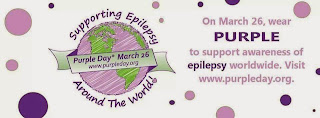Today, March 26th is Purple Day!
What is Purple Day, you ask?
"Purple Day is an international grassroots effort dedicated to increasing awareness about epilepsy worldwide. On March 26th annually, people in countries around the world are invited to wear purple and host events in support of epilepsy awareness. Last year, people in dozens of countries on all continents including Antarctica participated in Purple Day!"
Check out how Purple Day began here: purpleday.org
We always chuckle when October comes around and it's Breast Cancer Awareness Month - because really, who isn't "aware" of breast cancer? I'm sure the same can be said for most diseases, as well as epilepsy, but I think the "awareness" in Epilepsy Awareness is a little different. It's a silent disorder. Most of you who have met Cameron never saw him have a seizure and would never know he has epilepsy. The hardest part about living with someone who has epilepsy, or having epilepsy yourself is the unknown. Its relatively unpredictable for most people. So, what can you do??? Educate yourself!
So, what is Epilepsy?
Epilepsy is the fourth most common neurological disorder and affects people of all ages
Epilepsy is characterized by unpredictable seizures and can cause other health problems
Epilepsy is a spectrum condition with a wide range of seizure types and control varying from person-to-person
The seizures occur because of a sudden surge of electrical activity in the brain. This causes a temporary disturbance in the messaging systems between brain cells. During a seizure the patient's brain becomes "halted" or "mixed up".
Facts about epilepsy:
1. About 326,000 American children under the age of 15 have epilepsy and 200,000 new cases of epilepsy are diagnosed each year. Epilepsy affects people at different ages and in different ways. For some, it will be a temporary problem, easily controlled with medication and outgrown after a few years, but for others, it may be a lifelong challenge affecting many areas of life.
2. Even with today's medication, epilepsy CANNOT always be cured. Epilepsy is a chronic medical problem that for many people can be successfully treated. Unfortunately, treatment doesn't work for everyone. AT LEAST 1 million people in the United States have uncontrolled epilepsy. There is still an urgent need for more research, better treatments and a cure.
3. Epilepsy is NOT rare. There are more than twice as many people with epilepsy in the US as the number of people with cerebral palsy (500,000), muscular dystrophy (250,000), multiple sclerosis (350,000), and cystic fibrosis (30,000) combined. Epilepsy can occur as a single condition, or may be seen with other conditions affecting the brain, such as cerebral palsy, intellectual disability, autism, Alzheimer's, and traumatic brain injury.
4. What happens in a seizure may look different from one person to another. However, seizures are usually stereotypic, which means the same things or behaviors tend to occur in a person each time they have a seizure. The seizure behavior may be inappropriate for the time and place, but it is unlikely to cause harm to anyone.
If someone is having a seizure:
Loosen clothing around the person's neck.
Do not try to hold the person down or restrain them. This can result in injury.
Do not insert any objects in the person's mouth. This can also cause injury.
Reassure concerned bystanders who may be upset and ask them to give the person room.
Remove sharp objects (glasses, furniture, and other objects) from around the person to prevent injury.
After the seizure, it is helpful to lay the person on their side to maintain an open airway and prevent the person from inhaling any secretions.
After a seizure, the person may be confused and should not be left alone.
In many cases, especially if the person is known to have epilepsy, it is not necessary to call 911.
Call 911 if the seizure lasts longer than 5 minutes, or if another seizure begins soon after the first, or if the person cannot be awakened after the movements have stopped.
Cameron was sick with a fever and vomiting early this week and for the first time in his life, did not have a seizure when he was feeling under the weather! We feared it, because the last time he had a fever we ended up in the ER. What a relief! We're truly thankful for the work and help that the doctors at CHaD have provided us. You can check out how they help kids with epilepsy here: CHaD Kids
Sources:
Medical News Today
Epilepsy.com
Seizure First Aid



No comments:
Post a Comment